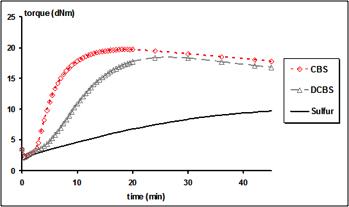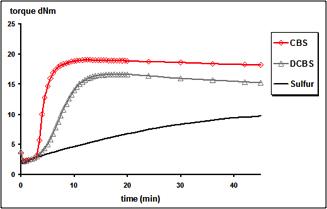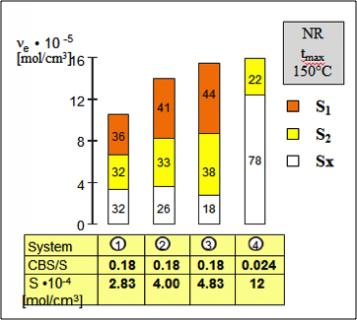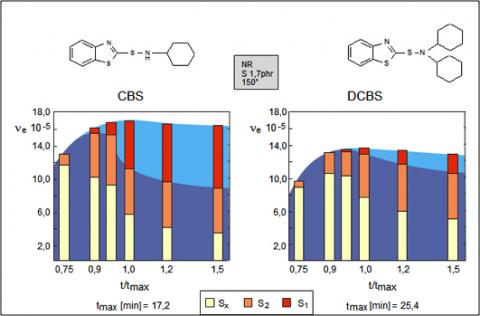Rubber has become an indispensable part of the modern world. Whenever machines and engines require the use of bearings, whenever forces are transmitted and liquids are transferred, whenever rotating shafts and containers must be sealed, there is no getting around this material.
Generally rubber can be cured with sulfur for manufacturing tires or general rubber goods. The chemical reaction between sulfur and the rubber chain is extremely slow and inefficient process. It was measured that this reaction takes around 6 hours at 140°C which is uneconomical by any production standards. Rubber articles made of this process are extremely prone to oxidative degradation and do not possess adequate mechanical properties for practical rubber applications. Additionally by adding a low content of sulfur the rubber becomes soft, by adding a high amount of it the rubber becomes hard. These limitations were overcome through the development of accelerators. They increase the speed of the chemical reaction so that a rubber article can be produced e.g. in 10 min at 170°C.
The function of an accelerator is firstly to activate the sulphur, i. e. to open up the ring-shaped molecule (S8) and form precursors with the S-atoms. The precursor then transfers the sulphur, together with the attached accelerator residue, to the rubber molecule. The reaction of this pendent group with a further rubber molecule chain and the splitting-off of the accelerator residue cause the actual crosslinking.
Therefore, the interaction between sulfur and accelerator plays an important role in the rubber industry. This paper investigates both a conventional high-sulfur cure Natural rubber (NR) based system and a low-sulfur cure NR system (semi Efficient Vulcanizing system) and includes an evaluation of the influence of the cure system on network properties.
Generally, the sulfenamide class accelerators are most popular in the rubber industry due to their delayed action as well as faster cure rate offered by them during vulcanisation of rubber compounds containing carbon black. For the investigation two sulfenamide accelerators have been choosen; N-Cyclohexyl-2-benzothiazolsulfenamid (CBS from LANXESS under Vulkacit® CZ) and N,N-Dicyclohexyl-2-benzothiazolsulfenamid (DCBS; from LANXESS under Vulkacit® DZ). They are compared to a reference NR compound containing only sulfur. A general truck tire compound formulation has been used.
As shown in figure 1, the vulcanisate of NR with sulfur alone shows a very long cure time at 150°C. Even this behaviour can be observed by using a lower level of sulfur as shown in figure 2. Additionally the vulcanisation plateau is nearly not reached after 40 min.
By adding CBS or DCBS to the NR compound the scorch and cure time is reduced rapidly in both cure systems. The CBS curve shows a shorter scorch time compared to DCBS. An increase in dosage of CBS or DCBS show improvement in scorch delay, cure rate and state of cure compared figure 1 to 2.
Generally both curves rise steeply until the onset point. After the Maximum Torque has been reached the curves show a decrease in figure 1. This part of the curve is an indication of degradation of the compound resulting in breakdown of crosslinks (reversion). In figure 2 both curves show a good vulcanisation plateau (stable curve after the maximum of torque) resulting in a good resistance to ageing and good compressing set behaviour.
The CBS compound shows a higher torque compared to DCBS. The torque value is an indication for the crosslink density. DCBS shows therefore a lower crosslink density (also seen in figure 4) which is due to the chemical structure of DCBS. It reaction time is also longer compare to CBS.

Figure1: Vulcanisation of NR at 150°C, 2.5 phr Sulfur and 0.6 phr accelerator

Figure 2: Vulcanisation of NR at 150°C, 1.5 phr Sulfur and 1.5 phr accelerator
It is known that sulphur vulcanization gives predominantly long polysulfidic crosslinks. It is obvious that long sulphur bridges tend to break, i. e. to re¬crosslink and revert and therefore change the physical properties of a vulcanisate.
A sulphur plus accelerators system has therefore two basic characteristics:
• the kinetics of the network formation
• the stability of the network produced
The chemistry of sulphur vulcanisation and the changes in crosslinking structure of NR vulcanisates are described by Chapman and Porter1. Short sulphur crosslinks provide high temperature stability2, but insufficient tear and dynamic properties. As an example in tire application polysulphidic crosslinks are most preferred due to their outstanding tear and dynamic properties.
The influence on CBS/sulfur ratio has been analysed. In figure 3 it can be shown that the ratio has a big influence on the crosslinks in the vulcanisate. Used at the same ratio CBS/sulfur the vulcanisates show with increased dosage more mono-sulfidic crosslinks and less polysulfidic crosslinks (system 1-3). With more free sulfur and less CBS (system 4) the vulcanisate has high amount of polysulfidic crosslinks as expected.


Figure 3: Influence on accelerator/sulfur ratio (NR compound at 150°C)
Additionally a comparison of the development of Crosslink Density (XLD) and Distribution of Crosslink Structure (XLS) with a CBS and DCBS based NR compound was analysed. The data are measured at different points t75, t90, t100, t120 and t150. 2.5 phr CBS and 3.3 phr DCBS have been taken to have an equal molar concentration.
The results are shown in figure 4. The distribution of the crosslink structure changes during time resulting in the change of crosslinks from mainly polysulfidic crosslinks to more mono- and di-sulfidic. A CBS containing NR compound builds more mono- and disulfidic crosslinks during time compared to DCBS based compound.

 Figure 4: Development of XLD and XLS with CBS and DCBS
Figure 4: Development of XLD and XLS with CBS and DCBS
As shown the accelerated sulfur vulcanization produces different sulfur containing network structures. Additionally the ratio of sulfur and accelerator has a huge influence on the properties of a vulcanisate.
CBS and DCBS are only two accelerators of the sulfenamide class. There are many other accelerators available for the vulcanisation of rubber which show a wide variety of properties in vulcanisate.
LANXESS as a globally operating supplier of high quality industrial chemicals supports the rubber processing industries with a broad range of products and proven technical expertise. Beside its accelerator portfolio, antidegradants and mastication agents show excellent properties in rubber articles such as conveyor and transmission belts to seals, hoses, latex articles.
----------------------------------------------
References
1. A.V. Chapman and M. Porter, “Natural Rubber Science and Technology“, A.D. Roberts Ed., Oxford University Press, Oxford, 1988, 511-620




